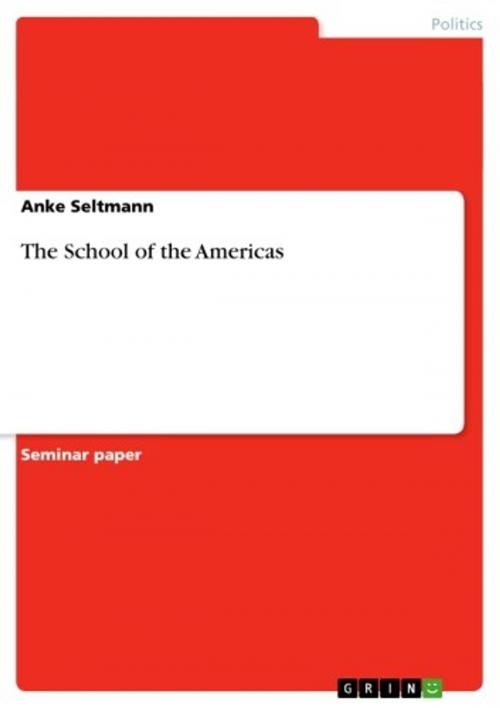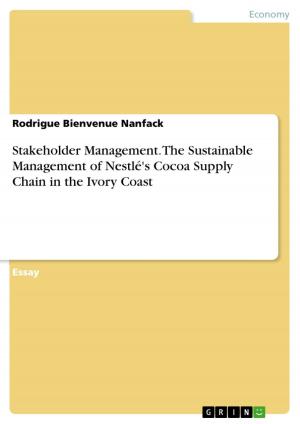| Author: | Anke Seltmann | ISBN: | 9783640371754 |
| Publisher: | GRIN Publishing | Publication: | July 13, 2009 |
| Imprint: | GRIN Publishing | Language: | English |
| Author: | Anke Seltmann |
| ISBN: | 9783640371754 |
| Publisher: | GRIN Publishing |
| Publication: | July 13, 2009 |
| Imprint: | GRIN Publishing |
| Language: | English |
Seminar paper from the year 2006 in the subject Politics - International Politics - Region: USA, grade: A, Uppsala University, course: Culture in Armed Conflicts, language: English, abstract: 1 The School of the Americas 'Chartered by the U.S. Congress, the Western Hemisphere Institute for Security Cooperation (WHINSEC - former: the School of the Americas) provides professional education and training for civilian, military and law enforcement students from nations throughout the Western Hemisphere' . The Institute's Mission according to the self-projection on the website of the WHINSEC is the following: 'Our mission comes directly from the Congressionally approved legislation that authorizes and directs WHINSEC's existence (10 U.S.C. § 2166). The purpose of the Institute is to provide professional education and training to eligible personnel of nations of the Western Hemisphere within the context of the democratic principles set forth in the Charter of the Organization of American States (such charter being a treaty to which the United States is a party), while fostering mutual knowledge, transparency, confidence, and cooperation among the participating nations and promoting democratic values, respect for human rights, and knowledge and understanding of United States customs and traditions.' The WHINSEC is an U.S. Army facility at Fort Benning in Columbus, Georgia. A precursor - the Latin American Ground School - was established in 1946 in the Panama Canal Zone. After some changes this U.S. Army facility, training especially Latin American military personnel, became the School of the Americas (SOA) in 1963. In 1984 it was relocated to Fort Benning in Columbus, Georgia. As Lesley Gill points out 'the establishment of the Ground School coincided with renewed U.S. expansionist ambitions in the Americas and partially filled a power vacuum created by World War II, which ruptured long-standing military ties between European imperial powers - particularly France, Italy, and Germany - and Latin American.' Further she argues that, 'the Ground School, however, did much more than train students in the tactics of warfare. It initiated their incorporation into the ideology of the 'American way of life' by steeping them into a vision of empire that identified their aspirations with those of the United States, a process that, [...] continues today.'
Seminar paper from the year 2006 in the subject Politics - International Politics - Region: USA, grade: A, Uppsala University, course: Culture in Armed Conflicts, language: English, abstract: 1 The School of the Americas 'Chartered by the U.S. Congress, the Western Hemisphere Institute for Security Cooperation (WHINSEC - former: the School of the Americas) provides professional education and training for civilian, military and law enforcement students from nations throughout the Western Hemisphere' . The Institute's Mission according to the self-projection on the website of the WHINSEC is the following: 'Our mission comes directly from the Congressionally approved legislation that authorizes and directs WHINSEC's existence (10 U.S.C. § 2166). The purpose of the Institute is to provide professional education and training to eligible personnel of nations of the Western Hemisphere within the context of the democratic principles set forth in the Charter of the Organization of American States (such charter being a treaty to which the United States is a party), while fostering mutual knowledge, transparency, confidence, and cooperation among the participating nations and promoting democratic values, respect for human rights, and knowledge and understanding of United States customs and traditions.' The WHINSEC is an U.S. Army facility at Fort Benning in Columbus, Georgia. A precursor - the Latin American Ground School - was established in 1946 in the Panama Canal Zone. After some changes this U.S. Army facility, training especially Latin American military personnel, became the School of the Americas (SOA) in 1963. In 1984 it was relocated to Fort Benning in Columbus, Georgia. As Lesley Gill points out 'the establishment of the Ground School coincided with renewed U.S. expansionist ambitions in the Americas and partially filled a power vacuum created by World War II, which ruptured long-standing military ties between European imperial powers - particularly France, Italy, and Germany - and Latin American.' Further she argues that, 'the Ground School, however, did much more than train students in the tactics of warfare. It initiated their incorporation into the ideology of the 'American way of life' by steeping them into a vision of empire that identified their aspirations with those of the United States, a process that, [...] continues today.'















